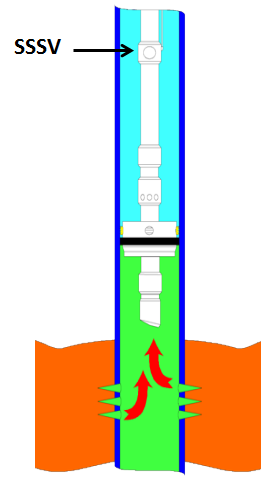Safety valves are designed to automatically shut in the flow of a well in the event surface controls fail or surface equipment becomes damaged. They are classified according to the location from which they are controlled – surface or subsurface. In this article, subsurface safety valve types, operating systems, working principle, setting depth, and selection process are presented.
It is advisable, and in most cases mandatory, to have a secondary means of closure for all wells capable of natural flow to the surface. The installation on of a sub-surface safety valve (SSSV) will provide this emergency closure capability.

Courtesy Halliburton
Types:
To isolate the tubing, there are two basic types of safety valves:
- Tubing conveyed: Tubing Retrievable Subsurface Safety Valve (TRSV),
- Wireline conveyed: Wireline Retrievable Subsurface Safety Valve (WRSV)
Operating Systems:
Operating systems may be either remotely operated on a fail-safe principle from surface (SCSSV) actuated from a control panel located on surface, or will be a subsurface controlled (SSCSV), designed to close automatically when a predetermined flow condition occurs in the well (actuated by the pressure differential/flow velocity across the valve).
In case of SCSSV, a 1/4″ inch stainless steel control line is attached to the outside of the tubing string and installed when the tubing is installed. Depending on the wellhead pressure, it may be necessary to keep as much as 4000 to 5000 psi on the control line to keep the valve open.
The differential type subsurface controlled subsurface safety valve senses pressure drop across a flow bean. There are several variations of the differential type SSCSV. Although they employ different sealing devices, such as a flapper or ball, they all are controlled with a flow bean and spring tension.
Working Principle:
As shown in the following video, when hydraulic pressure is applied down a control line, the hydraulic pressure forces a sleeve within the valve to slide downwards. This movement compresses a large spring and pushes the flapper (in case of flapper type SCSSV) or the ball (in case of ball type SCSSV) downwards to open the valve. When hydraulic pressure is removed, the spring pushes the sleeve back up and causes the flapper (or the ball) to shut. In this way, it is failsafe and will isolate the wellbore in the event of a loss of the wellhead.
Courtesy NTNU – IPT, Trondheim, Norway
Setting depth:
The location of the downhole safety valve within the completion is a precisely determined parameter intended to optimise safety. There are arguments against it either being too high or too low in the well and so the final depth is a compromise of all factors. MMS regulations state that the valve must be placed no less than 100′ below the mudline.

SSV Selection Process:

NB: For more details, refer to API RP 14B: Recommended Practice for Design, Installation, and Operation of Subsurface Safety Valve Systems.
Reference:
- Subsurface_Safety_Valve_Basics (George E. King Engineering)
- Vocational Training – Book 5 – Wireline Operations and Procedures
- CONCEPT 2 COMPLETION PTE LTD, Safety Valves Catalogue
- Downhole safety valve
- Dowell Schlumberger, Oil and Gas Well Completions – Completion Components






Pingback: SSSV installation depth เอาไว้ลึกเท่าไรถึงจะโอเค – Oil man